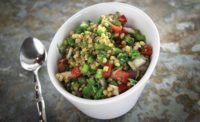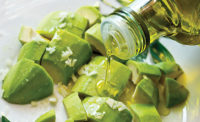Making Effective Use of Grains in Product Development
Using trendy grains and seeds calls for an expert approach

Focaccia from Ardent Mills

Chef Daniel Marciani, Executive Development Chef for Ardent Mills


Whole grains, and specifically ancient grains, add great texture, flavor, nutritional and artisan appeal to bakery foods. However, these ingredients can also create structural challenges in dough production. But with a few formula adjustments and a couple of recommendations when working with these products you can get to the right formulations.
When one pasta manufacturer wanted to include whole seed ancient grains in a rolled pasta formulation, it was apparent that the inclusions could make the sheeting process difficult and lead to dough tearing and unwanted yield loss. The first stage of the solution was finding the right flour with proper levels of protein, then fine-tuning the formulation to correct dough absorption to reflect the changes in the grain.
Since too coarse of a grainseed inclusion would cause problems when rolling pasta, a small seed like teff, turned out to be a good choice. Its fine, smooth texture delivered a great piece identity to the dough while keeping it “rollable” and pliable.
In baking, mixing times, dough temperature, absorption, and the effects other ingredients all are crucial, more so when making formulation changes. With pasta dough, white wheat flour keeps the dough lighter than red wheat, so it’s often a better choice for the base flour. This is usually followed by a 1-2% increase in liquid content. To keep color optimal, it might be necessary to reduce any added eggs.
The same basic process works when experimenting with inclusions like raisins, cranberries, and nuts in bread loaves. Adjusting the mesh size of whole grain flour can be used to alter the look of the finished bread, especially since having a nutty tasting, whole-grain base can really complement the final product.
It’s important to work with ingredient ratios in bakery and pasta products to maintain flavors of whole grains without overworking or altering the gluten structure. In cases where flavor isn’t coming through enough, certain culinary techniques like toasting seeds, nuts, and grains or even par-cooking them in flavorful liquids like stocks or pre-fermenting/sprouting them can bring more flavor into the process.
Using sweeteners is a common method for enhancing certain grain flavors. Honey and wheat is a popular pairing because both ingredients have warm, sweet notes. Honey also helps the earthy flavors of whole wheat and barley come through. Barley malt syrups tend to really support grains like rye and buckwheat the key dynamic at work for a toasted buckwheat sourdough in development. It featured a levain (sourdough starter normally made with white flour instead of rye) with whole grain dark buckwheat flour, a base of organic bread flour, toasted buckwheat groats, and malt syrup.
Pairing grain flavors with other ingredients is an emerging culinary idea. As consumers seek variety and flavor adventure on every possible element of a dish, whole grains and seeds can be a “final frontier” for adding value with flavor, aroma, visual appeal and texture.
In spite of growing interest, whole grains and seeds still are an underutilized ingredient in terms of global flavors and authenticity. In working with a multi-national pizza chain to develop on-trend, globally inspired crusts and toppings, a “grain up” approach made it possible to tell ingredient and culinary stories and connect grains to specific cultures.
For example, quinoa has a long, rich history in many Latin countries, but it is not used much in dough for regional items like papusas or tortillas. Quinoa also balances the rich, sweetness of carne asada, yet doesn’t get lost in the heat of chili peppers. It has clean, grassy, and floral notes that pair well with the bright, fresh flavors of Latin America. Along this line, quinoa flour was employed as a flavor booster in papusas and tortillas as well as Latin-influenced “pizza.”
Teff, an ancient grain widely used throughout Africa in fermented-dough breads such as Ethiopian injera, has nutty, almost chocolaty notes that can stand up to strong, aromatic ingredients like cumin, coriander, garlic, mint, curry, and lamb. One of the bolder recipes recently developed included a buckwheat flour dough used to emulate the flavor and color of Japanese soba noodles in a flatbread application. The deep color and flavors of the buckwheat worked well with the bright red color and the sour umam flavors of a kimchi topping, dressed with hoisin sauce, blue cheese, carrots, and Napa cabbage.
As culinary mash-ups gain popularity, grains can even be used to bridge different cultures. For example, creating an Asian-Latin fusion with a quinoa and masa tortilla filled with Korean-style barbecue beef.
Today’s consumers have strong interest in knowing the details of all the ingredients they eat. It no longer is enough to put the simplistic phrase “multigrain crust” on a menu or label. It can be a significant marketing benefit to list each individual grain and tell its history, preparation, and health benefits. In addition to great flavor and texture, grains and seeds bring great storytelling to the table.
Originally appeared in the May, 2016 issue of Prepared Foods as Grain Training.
Looking for a reprint of this article?
From high-res PDFs to custom plaques, order your copy today!







